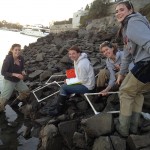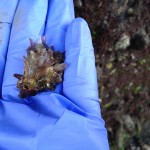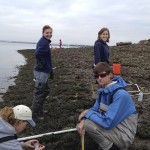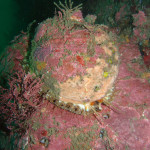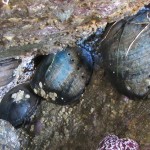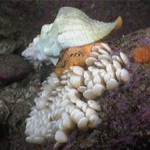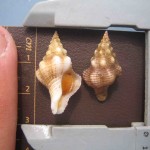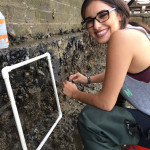Kellet’s whelk
Since 1996, Dr. Zacherl has been monitoring the population demographics of the predatory marine snail Kellet’s whelk (Kelletia kelletii). Kellet’s whelk is an emerging fisheries species (~150,000 whelk are harvested annually in California, up from nearly zero in the 1990s) whose range spans the U.S.-Mexico border and a network of marine protected areas in California. In the past several decades, it expanded its range northward to Monterey, past its historic range limit at Point Conception. Importantly, a large pulse of larvae recruited in the species’ expanded range following the strong 1997-98 El Niño – a pattern recorded as part of Zacherl’s Ph.D. thesis research. Zacherl teamed with former graduate student Sara Simmonds (formerly Koch) and collaborator Dr. Crow White at Cal Poly San Luis Obispo to conduct ongoing repeat population surveys in 2005-2006 and again in relation to the current 2015-16 El Niño to test the hypothesis that enhanced larval recruitment occurs at the poleward margin of the species’ range following El Niño events.
Oysters
We have been monitoring settlement dynamics and adult populations of oysters in southern California since 2005. Initially, our focus was on the native Olympia oyster, Ostrea lurida, the only native oyster species on the U.S. West Coast and Canada. In California, it was once widely distributed in bays and estuaries and was a harvested food resource for California native Americans but populations have declined dramatically since the early 1900s due to a combination of over-harvesting, pollution , and habitat loss/degradation. Restoration of the Olympia oyster is ongoing along the entire US West Coast, but little quantitative data exist on historic and extant populations in southern California. This motivated our interest in establishing long-term data sets on settlement/recruitment, adult density and size-frequency distributions in multiple bays in southern California, including Newport Bay, Alamitos Bay, and more recently, Huntington Harbor and San Diego Bay.
Over the past decade, we have noted an increasing presence of the non-native Japanese oyster, Crassostrea gigas. Particularly in the past few years, we have seen an increase in the numbers of juveniles at some of our monitoring sites, and this motivated a broadening of our focus to also study the settlement/recruitment, adult density and size-frequency distributions of this non-native species of oyster.
Abalone
Overfishing and disease have negatively impacted abalone throughout California. Former graduate student Kari Eckdahl surveyed rocky intertidal sites from Point Conception to Point Loma, CA to determine the overall abundance and density of endangered black abalone, Haliotis cracherodii, populations, and to assess the quality of potential black abalone habitat, while graduate student Amanda Bird is collaborating with NOAA NMFS to perform surveys of pinto abalone, Haliotis kamtschatkana, in San Diego, California where one of the only known southern California populations of pinto abalone is present, to determine population structure, habitat associations, and reproductive potential.
Our research on abalone demographics will provide up-to-date information regarding the status of these imperiled species and will inform management strategies.

